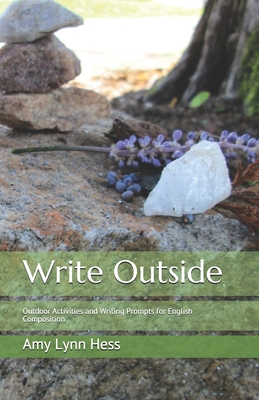
Hess, Amy Lynn
Write Outside is a handbook for college-level English composition courses. In addition to providing explanations and examples of effective writing strategies, the text includes outdoor activities and writing prompts that bridge and reinforce those key concepts.
As one of the best ways to clear our minds and think deeply about our own ideas, being outdoors is intrinsically linked to the basic principles of effective writing. Being outdoors is not only about "unplugging" or taking a break from technology, but also offers students innumerable opportunities to experience a tangible, natural world. The psychological and physiological benefits of sunshine and fresh air cannot be underestimated. Additionally, structured or group-based outdoor activities give students shared, meaningful experiences on which to base their writing. Structured outdoor activities can help students who otherwise do not have an opportunity develop an appreciation for the natural world. The greatest gift simply being outdoors offers is the gift of quiet moments for unbroken thought. What is writing if not the culmination of hours of unbroken thought?
In addition to an introduction that defines and offers explanations of paragraphs and essays, the book's contents are divided into three sections based on three core concepts of English composition:
- Modes of Communication
- Rhetorical Appeals
- The Writing Process
Each section has been further divided into chapters that can be completed in any order, or the chapters can be used as supplemental readings, assignments, or bridging exercises in coordination with other texts. Key words and phrases that may be unfamiliar to students have been indexed.
The outdoor activities suggested in each chapter are based on the idea that active learning practices are an inclusive pedagogy. These practices help students engage with one another, reduce their fears of writing, and increase successful completion of composition courses. The activities are appropriate for most geographical locations at any time of year, and for those working alone or with others. The activities give students opportunities to draw upon their creativity, practice both divergent and critical thinking skills, and collaborate. The activities might culminate in discussions, finished art projects, musical compositions, notes for use in written drafts, group projects, or multimedia presentations.
The writing prompts are also broad and can be adapted by faculty in a variety of ways, including assignment length, scope or word count, level of formality, research requirements, and formatting or citation style. The instructions for each writing prompt also leave room for student creativity and individuality. Each chapter's instructions follow the steps in the writing process, which are briefly explained within the instructions and explained in greater detail in the third section of the book. Drafts that stem from the writing prompts might emerge as prewriting exercises, journal entries, graded written assignments, research documents, outlines, speeches, group presentations, blog posts, online discussions, or submissions to publishers.
To put it succinctly, the outdoor activities and guided writing prompts are meant to be useful in whatever ways faculty and students may need them to be - all while giving them permission to simply spend time outdoors.







